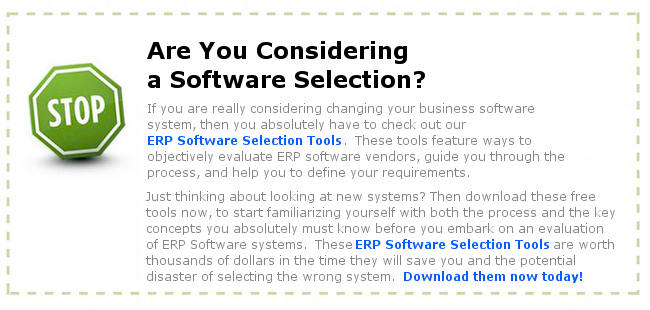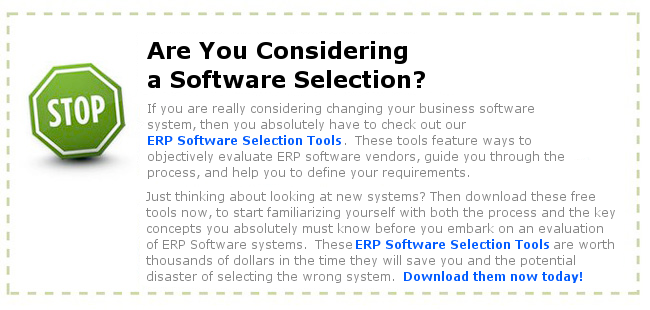Does Innovation Through Acquisition Work? – Forbes.com
Microsoft’s acquisition of Great Plains to link front-end applications with enterprise resource planning (ERP) applications is a case in point, Chaudhuri notes. “The idea behind the deal is to have seamless integration between the back-end ERP applications, like manufacturing planning, supply-chain management, HR management and financial accounting, and front-end Windows and Office applications. But since Great Plains’ relationship-based consulting approach, supporting processes and IT systems are very different from Microsoft’s infrastructure (which is geared toward selling packaged software), these differences are naturally taking time to be reconciled,”
Tag: ERP Software
PLM more than just hype
Previously, a company would have agonisingly developed drawings, physical models and made endless expensive tests before taking a product to market with little or no proven prospects it will return a profit. Now it is a case of utilising available market data and actually fast tracking a product or service to exactly meet the criteria dictated by current market demand.
But instead of time-consuming drawings, these are designed, tested and refined quickly and accurately in the digital 3D environment, so wastage is virtually negligible.
Product Lifecycle Management – Edge Software Australia – PLM more than just hype
Process Manufacturing – What is it?
Process manufacturing is the way chemical, food, and liquids manufacturers work. This is different from what how discreet manufacturers (manufacturers who make tangible items) run their operations. This is explained more on our post The Process Manufacturing ERP Buyers Guide
Sick of pop-ups
While working on an ERP implementation, I had a friend not so long ago complain to me that his daughter was using his laptop at home and now he gets tons of pop-up ads, and the system seemed so slow. I explained to him that that is often the case when you use Internet Explorer. I suggested using Mozilla’s firefox to him. We ran a few different anti-spyware programs to clean the machine, installed Firefox and he took it home. I instructed him to teach his daughter to only use Firefox from now on.
A couple months later, he came back to me and thanked me a lot. “Ever since she has been using Firefox, I do not have any junk on my computer and those crazy pop-up windows have stopped.” I smiled and nodded knowingly.
Firefox is a great browser and has all of the features of IE and then some. It has tabs that help you to browse many pages in the same window. It also has quite a really great plug-ins. Plug-ins are programs that can be downloaded and can extend your browser’s capabilities. I have my browser controling my Itunes for music, showing me the weather in the bottom status bar, using Pluck to read RSS feeds – right from the browser and a few more.
Please give it a try. You won’t be sorry. Download the free browser now at:
Microsoft Dynamics CRM 3.0 Has Arrived!!
Microsoft Dynamics CRM 3.0 Has Arrived!!
Microsoft has sped to market their latest CRM offering!
A flash presentation of the CRM tool can be found here.
ERP is in the picture for midsize manufacturers
Small and midsize manufacturers are increasing IT investment because they don’t have the IT architecture needed to compete in a demand-driven world. For many, this means going back to the basics: an ERP system that standardizes business processes, extends the company’s reach, and reduces overhead.
In a 2005 study of more than 550 companies’ ERP investment plans, only 27 percent of small companies “those with fewer than 500 employees” currently …more… (requires registration)
Your Web Based Future
Chris Shaul
With Google and Sun collaborating to bring a web based version of Open Office to consumers, Microsoft has now jumped into the web applications game, but with bigger plans than just an office suite. How about a web based ERP system from Microsoft?
Okay, now that is nothing new. There are plenty of html based ERP systems. Some such as Oracle, are purely a virtual application, being written in Java and launched from a browser. But with Microsoft planning this, the entire desktop and user applications may change. We may have only virtual applications in the future with you only licensing what you use and need. This includes running your company on a virtual, remotely hosted system. This, as mentioned, is not new. But the difference is that you would only need a computer with light processing power and an internet connection to literally run your financials and operations.
With a powerhouse like Microsoft pushing web applications, the future of computing will dramatically change. No more will you go down to the computer store and buy boxed software. You will log into your browser, find the application you want on the Internet, and then subscribe to do your wordprocessing, spreadsheets, companies financials, enter the latest customer orders, etc.
The independence you now have of choosing what is on your computer will diminish as a few market leading applications vendors host your software. The web and software in general are becoming more and more of a utility. Just as the electicity you buy, the cable tv you watch, and the gas that heats your food are all utilities, the web and all of its applications will soon be similar. The question is, who will control this utility? The DSL providers, the Software providers, the web hosting companies? We will probably see a shift in the landscape of Internet companies. Microsoft or some similar entity will begin buying the access control points to the internet. Time Warner is an example of an early adopter. Trying to own the content and the access. But when folks are using the ERP systems and the office suites of the web, then the megacorps will want to charge for the access to and the use of the content.
For now, the one thing that is working against these plans are the fact that most companies do not want someone else having control over their data. But as the costs are reduced to a utility point of view, it will only make sense to outsource. This unfortunately will put a lot of data into the hands of the “utility” companies. Think of the marketing info they could gain and what if your company’s data is not so secure? It is a brave new world that we are embarking upon. And to have an ERP system that is hosted, maintained, and monitored by an outside entity that is not in the business of hosting, but rather in the business of providing content and access is a rather scary nightmare. But for now it is okay. We have years before this becomes a reality…maybe.
Chris Shaul is a Sr. IT Consultant specializes about ERP selections and implementations.
ERP and Lean
Chris Shaul
Today, many ERP vendors are offering Lean Manufacturing modules in their solutions. These modules propose to assist companies in their lean effort. The real question is to what degree will these modules be used. Can a traditional manufacturer going to a lean model utilize a lean software tool immediately? When implementing an ERP system, process redesign is a must. The change that must occur in order to support an ERP system can be tremendous. But can a company bite off and digest all of the changes? Which should be done first, lean or ERP? These are all some of the questions that a typical manufacturing manager who is about to embark on an ERP implementation might ask.
First, lets define a few things. Lean is the removal of waste within a process and the concept of pulling items to a demand. It is also known as the Toyota Production system as it was developed and refined by Toyota in Japan. ERP is a business process enabled by software tools. It is not a software project! ERP streamlines your information flow such that it parallels your process flow. ERP works to build product to a forecast and then execute a production plan and inventory purchases synchronized to meet the predicted and actual demand. Lean, on the other hand, uses a pull system to meet an actual customer requirement. Lean uses the philosophy of smaller batches and reduction in non-value-added activities to create a much shorter lead time, thus delivering faster to a customer. ERP does not by its’ nature drive efficiencies in the production process. It only provides planners with information on what is going on and allows them to plan faster. If the process is broken, then automating it with the use of ERP will only highlight the problems.
What is the answer? The answer for many is to implement lean as part of an ERP intiative. Some would say that it should be a predecessor to an ERP initiative. Lean purists will argue that you do not need MRP and MPS to drive the production. ERP folks will argue that MRP and MPS are essential to having parts in-house and suppliers coordinated with the production. The answer for most companies is a hybrid solution, where lean is driving waste from the production and supply chain process (although also in the above-the-shop-floor activities too), while ERP is being implemented, such that you are automating value added processes and not trying to replicated waste processes in your new system. MRP can be used to plan longer lead time items, or items with higher value, whereas a Kanban can be setup for the faster turning and less expensive items.
Working from the perspective of a hybrid model, lean principles and practices can be implemented just prior to the ERP initiative. Then during the ERP implementation, the lean concepts must be considered and utilized in the setup of the new system. Tools such as Value Stream Mapping can define areas for quick improvements. Then once those improvements are made, a process flow based on the future state model can be applied to the ERP system. For example, a production cell might be setup for a particular product line with kanban inventory control. This would change how you would define your production process in the ERP system. Better ERP systems can run in this hybrid mode of traditional MRP and modern Lean concepts. Some product lines might be more suited to the MRP/MPS method because of supply chain issues or because of the long lead times that are associated with the products. Other product lines might be easy to immediately switch to flow manufacturing. Because of this, you want a system that can handle both methods.
Using a hybrid model, you select and position the ERP system to work alongside your lean initiatives. By leaning out processes (above and below the shop floor), you are avoiding “automating the mess.” Doing so will shorten lead times, reduce inventory, reduce production costs, improve employee moral and streamline your ERP implementation. Be sure to choose an implementation partner that is familiar with lean and is able to work in a hybrid manner. What order should these two tranforming intiatives occur? It might be best to have the lean initiative lead the ERP intiative by a few months. Then begin to implement the system. But do not stop the lean transformation. That should now be an ongoing philosophy of continual improvement. Use it to your advantage during the ERP implementation. Doing so will only help you on go-live day.
References:
http://www.advancedmanufacturing.com/September00/informationtech.htm
http://www.lean-manufacturing-info.com
http://www.qad.com/company/newsroom/lean_value.html
http://www.mapics.com/software/EE/SyteLine/sl7-aps.asp
http://www.cmtc.com/
http://www.inventoryinc.com/complimentary.html
Chris Shaul is a Sr. IT Consultant and specializes about ERP selections and implementations.

